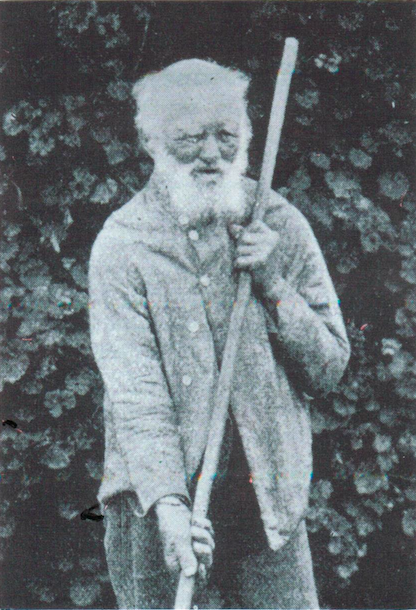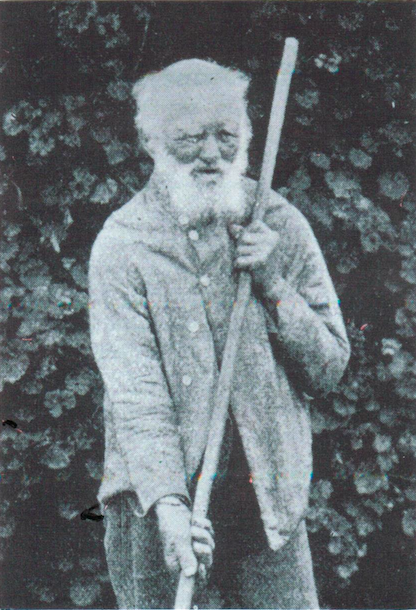The name of Sammy Cox was already entrenched in folk lore as I was growing up at Bishopsbourne in the 1940s/1950s where, for a period, he had worked as a gardener. His celebrity status was due in part to his longevity, reaching the age of 117 years and of having lived with the Aborigines for between 23 and 25 years.
However Sammy’s fame had started even in his life time as evidenced to the time when, at the age of 115 years, he appeared before a Launceston magistrate on the charge of being intoxicated in the street. It would seem that the magistrate held some sympathy and respect for Sammy commenting that the old fellow should be given a presentation instead of a fine. But duty prevailed and the magistrate inflicted a minimum fine of five shillings on him.
The local folk lore also went on to say that Sammy on reaching the age of 107 years, set about digging his own grave in the orchard near his home at Carrick. In this grave he maintained a lighted candle so as to ward off evil spirits.
Sammy was to live at Carrick for over 50 years, his home being a small wooden cottage at The Little Moat located opposite Monds’ flour mill. On several occasions he had to be rescued from his home by boat due to flooding. There is also record of him having a cat by the name of Joey which he used in hunting rabbits.
Throughout his life time Sammy frequently related his story to anyone who would listen and so incredible was it that some took the time and effort to record some details. One of these was Mr. T.W. Monds who owned and operated the Carrick flour mill near Sammy’s home and who had befriended him.
Sammy would recall that he had been born Samuel Emanual Jervis at Shenstone Park, near Lichfield, England on 15 November 1773. When he was about 10 years old his father, Squire Jervis, was killed by a fall from his horse while hunting. Samuel became the ward of his uncle, John Jervis his father’s younger brother. Probably unknown to Sammy this uncle, Sir John Jervis, was afterwards made Earl St. Vincent and became an Admiral.
Initially young Samuel, on his father’s death, was enrolled at Escot College, but his stay there was short as soon he was taken to sea by his uncle, learning about seafaring. In the next five to six years they sailed to a number of different parts of the world.
His last voyage was to the South Seas aboard the “Regent Fox” and which in 1789 reached the northern coast of Tasmania, where they stopped to replenish their water supply. This stop is generally believed to have been in the Tamar River region.
However Sammy had heard rumours from other crew members that his uncle was planning to get rid of him by stranding him on a deserted island and then claim his inheritance.
Sammy went ashore with the water party but fearing for his life decided not to return and went and hid in the bush until the “Regent Fox” eventually departed. A group of Aborigines soon found him and welcomed him to their tribe and with whom he was to live for at least the next 23 years. Around 1812 he made contact with a group of white settlers near what is now Hadspen and soon after attached himself to the Elias Cox family who had been granted land in the Pateena district of Longford, where also Sammy took on the surname of Cox.
In his article, which appeared in “The Examiner” newspaper in 1890, Mr. Monds went on to say, “Since that time he (Sammy Cox) has generally worked as a gardener in the districts of Muddy Plains (Pateena), Longford, Bishopsbourne and Carrick.
A few months ago the writer persuaded the old man to go into the Launceston Invalid Depot, but he was a spirited old fellow, and considerable difficulty was experienced before he could be persuaded to change his free and independent life for the restraint of the hostel for invalids.”

It was there that Sammy Cox or Samuel Emanual Jervis died on 5 June 1891 at the age of 117 years and a resident of this State for 102 years.
Some efforts have been made to verify Sammy’s story but with only partial success. However a number of prominent people who met with him generally accepted his story. Further in 1900 the Launceston Benevolent Society, the operators of the Invalid Depot, received a letter from a Mr. E.W.T. Jervis of Frankston, Victoria who claimed to be a grand nephew of Sammy, seeking a photo of Sammy and anything that belonged to him as a memento and which he planned to forward onto Jervis relatives in England. Information contained in this letter also supported Sammy’s story.
Therefore it is possible, even likely, that Samuel Emanual Jervis alias Sammy Cox, was Tasmania’s first European settler and by inheritance should have succeeded his father as Earl St. Vincent in England. It also means that the “Regent Fox” had entered Bass Strait nine years ahead of its discovery by George Bass.
Possibly Sammy Cox deserves even more celebrity status and honour than which is currently afforded him.
Written by Ivan Badcock on 1 November 2004



We have been interested in the Sammy Cox story for a long time Admiral John Jervis being a 7 times removed cousin and have done a lot of research on both him and Sammy’s stories which seem to have many facts that do actually ring true. If anyone is interested we would be more than happy to share any information we have that might add to the case.